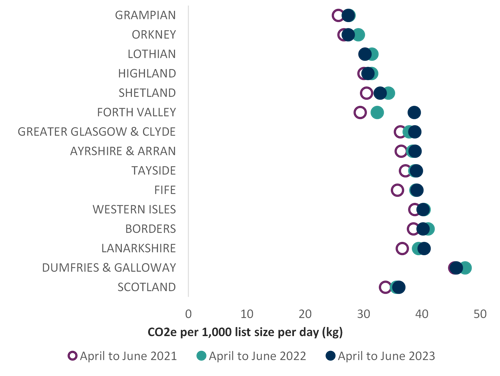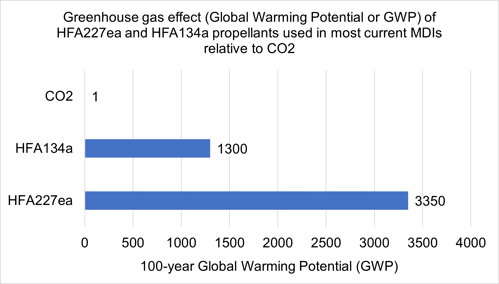CO2 emissions in Scotland

An ambitious target of 70% reduction in CO2 emissions from inhalers by 2028 has been set, as NHS Scotland works towards the commitment of net zero emissions by 2040. The 70% reduction has been split into biennial targets:
- a 25% reduction of CO2 emissions is required by the end of 2024
- a 50% reduction of CO2 emissions is required by 2026 and
- a 70% reduction by end of 2028
Prescribing indicators have been developed, as described below, to support achievement of the target.
- The chart below shows the CO2 equivalent emissions of inhaler propellant for each Health Board
- The calculation is based on an average of 12g of propellant per MDI. There are currently two types of propellants used, HFA-134a and HFA-227ea which have a global warming potential (GWP) of 1300 or 3350 times greater than CO2.The carbon emissions were estimated by multiplying the estimated weight of HFA propellant by its GWP. We have assumed that DPIs have zero emissions.8
- Note: other factors such as manufacturing process, plastics used and recycling potential are not included in these calculations.
CO2 emissions (kg) per 1000 patients on list size

The numerical data for NTI graphs can also be viewed here.
The most up to date national therapeutic indicator data is available here.
Rationale for CO2 emission target
- CO2 has a 100-year global warming potential (GWP) of one.
- pMDI’s contain the propellants HFA 134a or HFA227ea which have 1300 and 3320 higher GWP respectively then CO2.
- The figure below highlights the differences in GWP of the propellants.77
- All dry powder inhalers and soft mist inhalers have considerably lower GWP than pMDIs.
Global Warming Potential76

- New propellants such as HFA 152a and HFO-1234ze will have a low global warming potential and reduce the carbon footprint of pMDIs by at least 90%80,81.
- There is ongoing development of new propellants within the pharmaceutical sector, predicted to be available by 2025.
- PrescQIPP data is available which estimates an indicative total CO2 emission (g) for each inhaler based on the life cycle including manufacturing process, plastics used, recyclable material and propellants contained.82
- A lot of these factors are subject to change, so this guide has focussed on CO2 emissions of the propellant initially to allow NHS Scotland to meet the CO2 reduction targets set.
- It is acknowledged that recycling of inhalers within NHS Scotland needs to improve and at present it is harder to recycle a DPI.
Examples of MDI with different global warming potential
Very low GWP
SMI (soft mist inhaler)
- Spiriva® Respimat®
- Spiolto® Respimat®
DPI (dry powder inhaler)
- Accuhaler®
- Easyhaler®
- Ellipta®
MDI (metered dose inhaler) containing HFA152a
- inhalers containing HFA152a or other propellants are due in 2025
High GWP
pMDI containing HFA134a
- Salamol® Easibreathe®
- Clenil® MDI
- Seretide® MDI
Very high GWP
pMDI containing HFA134a (large volume cannister)
- Ventolin® MDI
pMDI containing HFA227ea
- Flutiform® MDI
- Symbicort® MDI
